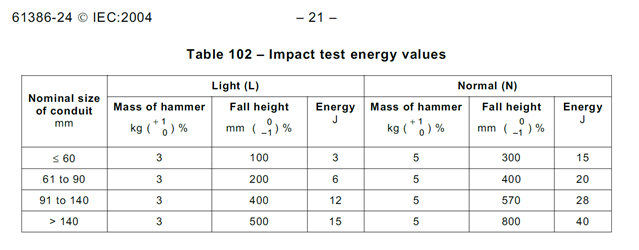I am hearing from my network that the DPC for AMD 4 went on line this morning and is available on the BSI website.
JP fires starting gun for a very long thread?
JP
I am hearing from my network that the DPC for AMD 4 went on line this morning and is available on the BSI website.
JP fires starting gun for a very long thread?
JP
Next one... does anyone know exactly what the "N750" designation for underground ducts mean? So far I've only gathered that 750 means 750 Newtons for crush resistance (over what sort of area I can't tell - if it were per mm² like concrete blocks that would be quite impressive, if it's over a much larger area, then maybe it won't necessarily cope with even me standing on it with one foot). "N" seems to be impact resistance of "normal" ... which doesn't tell much much as all.
As you might have noticed there's a suggestion in 522.8.10 that N750 duct will provide the equivalent protection as earthed armour ... which I'm a little doubtful of so far,
- Andy.
Andy,
Im sure you know some of this already, N450 Ducts under footpaths etc, N750 under roadways. Standard would be BS EN 61386-24:2010 and from what I can find testing is carried out and marking of duct as per the following;
" Corrugated cable conduits 450N and 750N are manufactured and tested in accordance with EN 61386-1 and EN 61386-24. With reference to these standards, each European country issues its own product marking: Cable Conduit Pipes are manufactured in accordance with the “Directive 2014/35/EU relating to electrical equipment designed for use within certain voltage limits” and CE-marked, so they do not fall under the ‘Construction Products Regulation’ nr. 305/2011.
Cable conduits must be identified with a durable and legible marking applied to the surface of the conduit every 1 to 3 metres.
The marking in accordance with EN 61386-1 and EN 61386-24 must contain the following information:
The tests required by the above-mentioned standards and often stated in the corrugated pipe data sheet are:
The main characteristics for the choice of corrugated pipe for regulation electrical installation are resistance to compression and impact.
Compressive strength is the most important characteristic since the pipe is buried and consequently subjected to the overlying static load. On top of this there may also be any load due to above-ground stresses such as the weight of vehicles. As defined by the standard, the corrugated cable conduit sample is crushed between two plates so as to deform the inside diameter by 5%; the force required to achieve this crushing must exceed 450N or 750N.
While compressive strength is a property that accompanies the Cable Conduit during its life, the impact test, on the other hand, serves to guarantee the duct during installation. The test simulates the accidental stresses caused by stones in the ground falling onto the surface of the structure during the burial phase. Therefore, the soil layer adjacent to the cable conduit should be free of stones larger than 80-100 mm in diameter. To test this characteristic, the sample, conditioned for 2 hours at -5°C, is hit by a dart with a fixed weight of 5 kg from a variable drop height depending on the nominal diameter of the corrugated pipes (300 to 800 mm height). At the end of the test, there must be no gap allowing water to pass from the inside to the outside."
Hope that helps a little.
Cheers GTB
As you might have noticed there's a suggestion in 522.8.10 that N750 duct will provide the equivalent protection as earthed armour ... which I'm a little doubtful of so far,
Also, to be pedantic 'equivalent protection against mechanical damage' is different to plain 'equivalent protection' when talking about the use of earthed armour.
It's also worth considering that the circuit may well be for an SELV system, or perhaps occasionally full electrical separation, where the earthed armour adds nothing even when considering 'equivalent protection' (without just the mechanical).
"N" seems to be impact resistance of "normal" ... which doesn't tell much much as all.
For the 'N' and 'L' classifications, these are tested using falling hammer test on conduit pre-conditioned at -5 deg C. Test mass as follows:

Pass criteria as follows:

"N" seems to be impact resistance of "normal" ... which doesn't tell much much as all.
For the 'N' and 'L' classifications, these are tested using falling hammer test on conduit pre-conditioned at -5 deg C. Test mass as follows:

Pass criteria as follows:

We're about to take you to the IET registration website. Don't worry though, you'll be sent straight back to the community after completing the registration.
Continue to the IET registration site